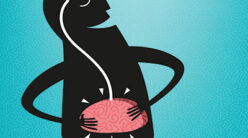What’s the safest way to shed excess pounds, avoid high cholesterol and heart disease, and even cut your risk for certain types of cancer? “With a vegetarian diet,” says author Neal Barnard, M.D. “It’s the most powerful prescription for health I can suggest.”
Although the average vegetarian is slimmer and healthier than the average meat-eater, says Dr. Barnard, there is still a good deal of skepticism that an entirely vegetarian diet can provide complete nutrition. After all, in 1928 presidential candidate Herbert Hoover rallied supporters by promising “a chicken in every pot.” The dream realized, Americans are more out of shape than ever, with obesity, diabetes, heart disease, and other diet-driven illnesses claiming many thousands of lives each year. So what if we traded those chickens for spaghetti marinara, veggie burgers, lentil soup, or even a bean burrito? Would we turn the tide on many chronic illnesses? Physicians and dietitians say yes.
Let’s debunk common misconceptions about vegetarian nutrition that may be keeping you from lightening up your diet.
How Will I Get Enough Protein?
The typical American eats more than twice the amount of protein necessary. Does this mean we are stronger and healthier? Unfortunately, no. “Excess protein causes significant calcium loss in the bones, increasing risk for osteoporosis and overworking the kidneys as well,” says Dr. Barnard.
Nutritionists describe it this way: A protein molecule is like a string of beads, each “bead” being an amino acid. When protein is digested, the beads break apart and pass into the bloodstream, making it slightly acidic. To neutralize the acidity, the body pulls calcium from bones and excretes it in the urine.
“Meat-based diets spell trouble for bones,” says Jen Keller, R.D., “while grains, beans, vegetables, and fruits easily provide enough protein without putting you in the danger zone for calcium loss.”
Human kidneys are unable to cope with frequent large protein loads, which are a big part of modern diets. Today it is not uncommon to eat an egg-and-cheese sandwich for breakfast, chicken salad for lunch, and fish for dinner. “Such diets force the kidneys to work harder, filtering by-products from the breakdown of protein,” says Dr. Barnard. “This can lead to progressive destruction of kidney tissue.”
Won’t All Those Carbohydrates Make Me Gain Weight?
While protein is getting undeserved praise in fad diet books, carbohydrates have been banished from dinner plates everywhere. Many people are missing out on pasta, rice, potatoes, bread, and even vegetables, for fear that these will turn to fat.
“The truth is, carbohydrates are not fattening. They are not even especially high in calories. A gram of carbohydrate from potatoes, bread, or pasta has only four calories, while a gram of fat from chicken, beef, or other sources has nine,” says Brie Turner-McGrievy, R.D. In fact, when carbohydrates are not loaded down with fatty sauces, oils, or butter, they can promote aggressive weight loss. This is because carbohydrates increase your metabolism-your basic calorie-burning speed- for hours after each meal. These calories are lost as body heat, not stored as fat.
The next time you are choosing items from the food bar or supermarket, consider this: six ounces of black beans contains 150 calories, while six ounces of skinless chicken breast has 280 calories. Complex carbohydrates are naturally low in calories, and they simply cannot add directly to your body fat. In fact, the conversion of a carbohydrate molecule into a fat molecule is complex and energy-consuming, using a full 23 percent of calories in the process. In contrast, beef or chicken fat can easily add to the fat on your body, as only 3 percent of their calories are used in the conversion.
Researchers at the University of Rochester asked a group of young men to drink a special carbohydrate solution, and then measured their metabolic rates. Blood tests showed that their calorie-burning speed had increased and remained elevated for more than two and one-half hours. All the while the subjects did no exercise, but rested comfortably in bed. Carbohydrates are like personal trainers for your cells. Each time you choose rice, pasta, or potatoes–cooked healthfully–you’re giving your body an internal fat-burning workout.
Isn’t Fish Clean and Healthy?
When you are choosing what to eat, it’s wise to consider the environment that many animals are living in today. Fish are hardly swimming in pristine waters; our waterways are the receptacles for sewage systems and pesticide runoff. The National Research Council reports that polychlorinated biphenyls (industrial chemicals used in electrical equipment, hydraulic fluid, and paper goods), or PCBs, are present in virtually every site where fish have been tested, even in remote spots of rural Alaska, the Virgin Islands, and Hawaii. These contaminants become densely concentrated in fish muscles and remain in the body of those who eat them for many years.
Another common contaminant in fish is mercury, a known contributor to Parkinson’s disease (a condition of abnormal muscle control), depression, irritability, and other psychiatric symptoms. One particular sampling of shellfish, tested at 145 different sites, found mercury in every single one. “As fish consumption is, by far, the greatest route of exposure, avoiding fish is the only way to eliminate this risk. When you get away from fish, you cut your exposure in half,” says Dr. Barnard.
Fish also adds more fat and cholesterol to the diet than many realize. For instance, you get 40 milligrams of cholesterol in a four-ounce piece of tuna and about double that amount from rainbow trout. Even more surprising is the amount of cholesterol in mobile shellfish, such as shrimp and lobster. Ounce for ounce, shrimp have double the cholesterol of beef.
Omega-3 fatty acids have received a lot of positive media attention in recent years. Although they are necessary for healthy skin, eyes, and nerves, the kinds found in fish (and fish oil capsules) are highly unstable molecules, decomposing quickly and unleashing free radicals in the process. “Vegetables such as broccoli, spinach, lettuce, and beans provide omega-3s in a form more stable and modest in quantity,” says Dr. Barnard.
Isn’t Some Red Meat Necessary for Iron?
There is a surprising side to iron, a treacherous and harmful side that can accelerate the aging process by encouraging free radical production. But you’d never know it by the way iron supplements were once marketed, with promises to provide “iron-deficient” women boundless energy and renewed zeal in the form of a pill. Most are gone now–and with good reason. “Given the way most of us eat, iron overload is more cause for concern than iron deficiency,” says Keller.
A trace of iron in your blood allows it to carry oxygen, a function necessary for life. However, your body carefully sequesters any surplus, storing it in special molecular containers called ferritin, where it remains in case excessive bleeding or dietary inadequacies compromise your iron stores. Your body also recycles iron from old, worn-out red blood cells. In the course of a day you will lose about one milligram of iron in urine, sweat, and cells that slough off your skin, hair, nails, and intestinal wall.
Why does your body work so hard to balance its iron supply? Because it knows that free-floating iron is dangerous. We can safely hold 100 to 300 milligrams of iron in our bodies, but when levels reach about 800 milligrams-the amount present in more than half of Americans-cell destruction is hastened.
Iron overload can make its presence felt in the form of fatigue, arthritis, weakness, impotence, diabetes, shortness of breath, loss of menstrual periods, and neurological problems. It can even contribute to heart attacks. It’s easy to avoid these health dangers by filling your plate with plant foods. Iron is abundant in beans and lentils and is also found in vegetables and grains. When you boil, steam, or stir-fry your vegetables you increase their usable iron even further. “No matter how many iron-rich vegetables you eat, your body can easily handle it, absorbing only what is needed,” says Turner-McGrievy. It’s a perfect system, until you add red meat, poultry, or fish to your diet.
Quite different from plant iron, meats contain heme iron, which simply doesn’t comply with your body’s iron-regulating system. Regardless of how much iron you already have, heme iron barges through the intestinal wall and into the bloodstream, adding to free radical activity and damaging cells.
Do I Need to Take Vitamins or Minerals?
Some of the most potent antioxidants are found abundantly in plant foods. Vitamin E is hidden in the natural oils in beans, vegetables, nuts, and fruits. After entering the bloodstream, vitamin E lodges itself into cell membranes, waiting to defend against free radical destruction.
The bright-orange color of carrots, sweet potatoes, cantaloupes, pumpkins, and other similarly imbued food signals high beta-carotene content. Adding these to your diet adds longevity to the life of your cells. Green and yellow vegetables carry this mighty antioxidant as well.
Whole-grain breads, pastas, rice, and cereals may not beckon you with brightness, but their grains contain selenium, a special nutrient that bolsters the enzymes that neutralize free radicals, stopping disease-causing reactions in their tracks.
And let’s not forget vitamin C. “Go for citrus fruits, strawberries, and green vegetables. It enters your joints, and invigorates the cells of many organs,” says Keller. “On a typical diet, you’ll easily displace these vitamin-rich foods with meats that have lots of fat and cholesterol, but not much in the way of protective nutrients.” To round out your diet, Keller recommends eating B12-enriched foods such as cereal or soymilk a few times each week, or simply taking a multivitamin.
A study in the American Journal of Clinical Nutrition comparing the diets of nonvegetarians and vegans (who consume no meat, eggs, or dairy products) showed that vegans came out ahead in most key nutrients, including vitamin A, vitamin C, and folate, even when comparing a vegan diet without supplements to a nonvegetarian diet with supplements. They also excelled in their intake of fiber, which is protective against a number of chronic diseases, and consumed vastly smaller amounts of harmful fats.
People’s nutritional awareness is slowly beginning to blossom. Health food supermarkets, full of fresh produce, have set up shop in nearly every town. Many restaurants offer vegetarian selections or will happily prepare a meatless version of any menu favorite. And for those who enjoy home cooking, vegetarian cookbooks and Web sites provide an endless supply of delightful culinary creations. “Today people don’t want to live on prescription drugs the way their grandparents did. They want to stay healthy,” says Dr. Barnard. “The best place to start is at dinner tonight.”






